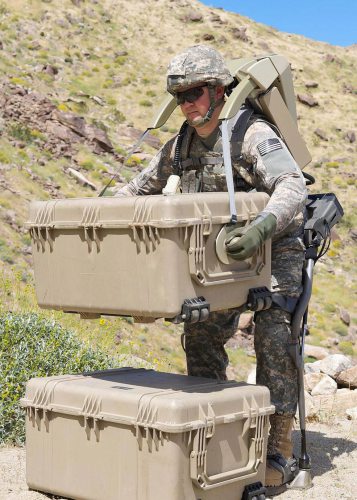“I accept the fact that as a Ranger my country expects me to move farther, faster, and fight harder than any other soldier.” This quote from the United States Army Ranger Creed demonstrates what the country expects of our best. America expects Soldiers to maintain a level of physical fitness well above the average U.S. citizen. However, a Soldier can only push their body so far before reaching a breaking point. What if there was a way to extend the time before the Soldier reaches this breaking point? Currently, Lockheed Martin is one of the organizations developing and testing a system that could do just that.
The Human Universal Load Carrier, or HULC, is an exoskeleton suit that reduces the effort spent by a soldier, while simultaneously increasing the amount of weight a Soldier can carry, and increasing the distance covered by a Soldier.
Normally, Infantry Soldiers carry over 100 pounds of weight on any given mission. Fatigue is a minor effect compared to injuries this level of physical exertion can cause.
Traditionally, Infantry Soldiers in the U.S. Army carry heavy loads for miles at a time to conduct patrols, ambushes, attacks, reconnaissance, and defensive missions. The issue with this is that the human body is only capable of carrying a certain amount of weight for a certain distance before injury or fatigue ensues. Normally, Infantry Soldiers carry over 100 pounds of weight on any given mission. Fatigue is a minor effect compared to injuries this level of physical exertion can cause. Stress fractures, skeletal injuries to include spinal injuries are the most common among longtime Infantry veterans. Injuries are a problem that no level of physical fitness or realistic training can completely prevent. However, an exoskeleton could be a solution to this problem.
As stated above, systems like the HULC are exoskeleton suits worn by a human. Suits like the HULC are generally made up of a power system, computer, and pieces of titanium that a user straps on. The HULC system, for example, can support up to 200 lbs of weight, while simultaneously allowing the user to maneuver effectively. Tests show that the HULC allows the user to stand for hours or crouch, kneel, and even lie down quickly. The system’s operating time is up to 8 hours at a time given no new batteries. This means that while the HULC is able to support a substantial amount of weight, it also can support a Soldier’s movements for an extended amount of time, without causing stress on the Soldier’s joints because of a decreased amount of physical exertion. Soldiers utilizing the HULC’s capabilities can move faster and farther while decreasing the energy spent. This allows the Soldier to not feel as much fatigue which in turn allows them to fight harder in combat.
Exoskeletons can also increase a Soldiers strength and endurance off the battlefield. Soldiers can utilize these systems to lift heavy objects such as ammunition, equipment crates, and vehicle parts with ease and less stress on their bodies. Currently, Lockheed Martin is developing attachments for the HULC system that will increase its variety of capabilities, which allows it to be used throughout other areas of combat that are not necessarily in the fight directly. Meaning other Soldiers, not just Infantry Soldiers, can use exoskeleton suits to complete their physically exerting tasks.
Exoskeleton suits change the way Soldiers can fight and ultimately changes the way Soldiers can participate in combat. These suits not only increase the strength and endurance of the strong Soldiers, but also increases the strength and endurance of weaker Soldiers. They allow Soldiers to accomplish more work with a decreased amount of physical exertion. It makes both the common Soldier and the Infantry Soldier more efficient in their everyday tasks and in turn could potentially even change the standards required of Soldiers. Having an increase in strength and endurance allows virtually any Soldier to complete a job that before could only be completed by someone who met the standard required to fill that role. This ability to put any Soldier in a role that they might not have previously been able to fill ultimately changes the effectiveness of the Army as a whole.
Ultimately, exoskeleton suits have the potential to change the battlefield. By increasing a Soldiers strength and endurance, they allow for greater adaptability, maneuverability, and lethality. This in turn increases the effectiveness and efficiency of the Army as a whole. Exoskeleton suits promise to let an Infantry Soldier “move further, faster, and fight harder,” while exerting less physical effort. These suits will change the assumption of an individual Soldier and ultimately the battlefield for future wars.
For more about the Exoskeleton see this video discussing future military technologies.
[Photos by Lockheed Martin]



